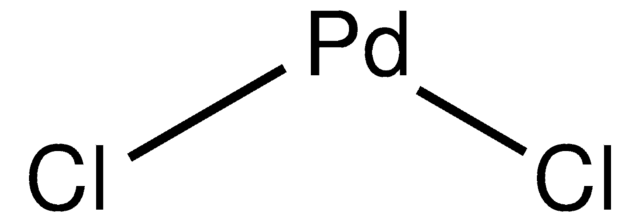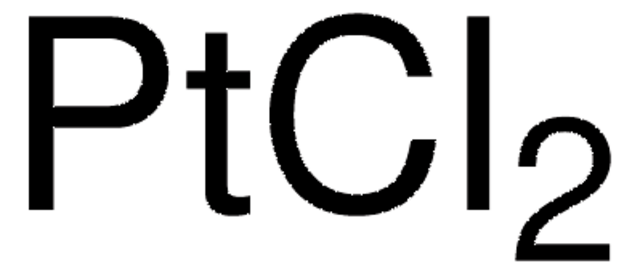205796
Potassium tetrachloropalladate(II)
98%
Synonym(s):
Potassium palladium(II) chloride
Sign Into View Organizational & Contract Pricing
All Photos(1)
About This Item
Linear Formula:
K2PdCl4
CAS Number:
Molecular Weight:
326.43
EC Number:
MDL number:
UNSPSC Code:
12352302
PubChem Substance ID:
NACRES:
NA.23
Recommended Products
Quality Level
Assay
98%
form
crystals
mp
105 °C (dec.) (lit.)
density
2.67 g/mL at 25 °C (lit.)
SMILES string
[K+].[K+].Cl[Pd--](Cl)(Cl)Cl
InChI
1S/4ClH.2K.Pd/h4*1H;;;/q;;;;2*+1;+2/p-4
InChI key
LGCKLDWLSVFMGL-UHFFFAOYSA-J
Looking for similar products? Visit Product Comparison Guide
Related Categories
General description
Potassium tetrachloropalladate(II) is a dark brown crystalline solid widely used as a Pd source in the field of catalysis, nanomaterial synthesis, and electronics.
Application
Potassium tetrachloropalladate(II) can be used:
- As a precursor to synthesize Pd nanoparticles for catalytic degradation of organic pollutants and Pd-GO electrocatalyst in formic acid and ethanol oxidation.
- To synthesize Pd–Pt alloy nanocrystals (NCs) with hollow structures by a galvanic replacement method with uniform Pd octahedral and cubic NCs as sacrificial templates. The hollow NCs exhibited higher ORR activities.
- To synthesize immobilized Pd catalysts, a versatile method involves the layer-by-layer deposition of PAA and PEI-Pd(II) on alumina, followed by the reduction of Pd2+. This approach offers several benefits, including the stabilization of particles through the polyelectrolyte matrix, introduction of selectivity, and a significant reduction in undesired isomerization. Expanding the application of polyelectrolyte films holds promise for further enhancing selectivity in hydrogenation and other reactions.
- To fabricate conductive and porous metal-organic frameworks(MOFs) for gas sensing applications and also to synthesize bimetallic Pd/SnO2 nanoparticles on metal organic framework (MOF) as an electrocatalyst for ethanol oxidation.
- To prepare rigid macrocyclic pincer catalysts possessing polyaromatic ligands with enhanced catalytic activity.
Features and Benefits
Used in the synthesis of semiconducting metal-containing polymers in which the polypyrrole backbone has a conformational energy minimum and is nearly planar. Reacts with bis(dithiolates) to metal-bis(dithiolates) with applications in laser Q-switch materials, optical CD recording media, bar code material and superconductivity.
Signal Word
Warning
Hazard Statements
Precautionary Statements
Hazard Classifications
Eye Irrit. 2 - Skin Irrit. 2 - STOT SE 3
Target Organs
Respiratory system
Storage Class Code
11 - Combustible Solids
WGK
WGK 3
Flash Point(F)
Not applicable
Flash Point(C)
Not applicable
Personal Protective Equipment
dust mask type N95 (US), Eyeshields, Gloves
Choose from one of the most recent versions:
Already Own This Product?
Find documentation for the products that you have recently purchased in the Document Library.
Customers Also Viewed
Mathis, M. et al.
Chemistry of Materials, 10, 3568-3568 (1998)
B L Iverson et al.
Nucleic acids research, 15(19), 7823-7830 (1987-10-12)
Reaction of DNA with K2PdCl4 at pH 2.0 followed by a piperidine workup produces specific cleavage at adenine (A) residues. Product analysis revealed the K2PdCl4 reaction involves selective depurination at adenine, affording an excision reaction analogous to the other chemical
A water-based synthesis of octahedral, decahedral, and icosahedral Pd nanocrystals.
Byungkwon Lim et al.
Angewandte Chemie (International ed. in English), 46(48), 9279-9282 (2007-10-31)
V A Tomilets et al.
Farmakologiia i toksikologiia, 44(1), 77-80 (1981-01-01)
A scheme has been devised that makes it possible to assess a specific mechanism of action of any histamine-releasing agent. The scheme suggests a switch off of different stages of histamine secretion--interaction of a histamine liberator with surface cell receptors
Can reliable information sources be trusted?
Malin Engfeldt et al.
Contact dermatitis, 65(6), 364-367 (2011-11-15)
Our team of scientists has experience in all areas of research including Life Science, Material Science, Chemical Synthesis, Chromatography, Analytical and many others.
Contact Technical Service









